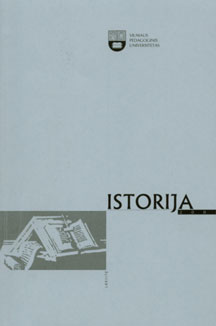Oikonimai su *kaim- Rytų Prūsijoje
Oiconyms with *kaim in East Prussia
Author(s): Grasilda BlažienėSubject(s): History
Published by: Vytauto Didžiojo Universitetas
Keywords: oiconym; appellative; origin; derivative; compound.
Summary/Abstract: The article investigates old East Prussian oiconyms which are closely related to the productive topolexeme *kaim-, derived from the appellative caymis, i. e. village. German chroniclers made an inventory of the total of Prussian proper names and oiconyms with *kaim on the basis of the living language. Recording from the year 1255 the oiconym Caym, which formally coincided with the appellative caymis, they defined the boundaries of the Prussian appellative lexis. The initiator and researcher of the index of the Prussian proper names G. Gerullis claimed that only those Prussian place names which had been recorded before 1525 could be investigated; this was the period when the German pronunciation of the Prussian place names became stable. The author of the article rejects this approach. In the article the author analyzed all oicinyms collected from the districts of Sambia, Nadrovia as well as northern districts of Notangia, Barta and Varmia. The author also researched and discussed oiconyms with *kaim- from the southern part of East Prussia which were overlooked by the Polish specialist in onomastics R. Przybytek who investigated Baltic oiconyms, i. e. those from the southern part of East Prussia. However, the 16th–18th century oiconyms with *kaim-, presented by the scholar, were not acceptable to G. Gerullis. The author of the article discusses each oiconym and gives special attention to its structure and the origin of the first component. The investigation shows that the first component in most cases is derived from personal proper names, sometimes from appellatives. The author also presents examples of obscure origin. The research proves that the frequency of oiconyms with *kaim- is higher in East Prussia than oiconyms with this topolexeme in Lithuania. In East Prussia they are considered to be the relicts of western Baltic substratum and adstratum, and appellative is the phenomenon of western Balts. This fact might be significant for the researchers of the Baltic history.
Journal: Istorija. Lietuvos aukštųjų mokyklų mokslo darbai
- Issue Year: 72/2008
- Issue No: 4
- Page Range: 10-20
- Page Count: 11
- Language: Lithuanian

